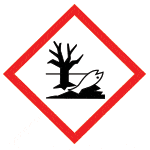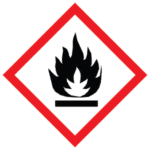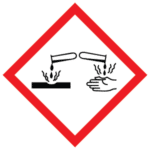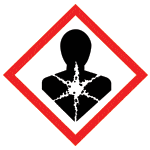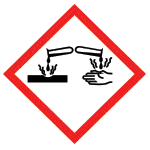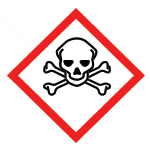Globally Harmonized System (GHS) specifies certain elements that should appear together on chemical labels. Like hazard statements, pictograms (symbols), and signal words which may be required on chemical labels, depending on the toxicity or hazards of the product, while precautionary statements, product identifiers, and supplier information are required on all labels.
Hazard statements
Phrase assigned to each hazard category that describes the nature of the hazard.
Examples of hazard statements are: “Harmful if swallowed,” “Highly flammable liquid and vapor” and “Harmful to aquatic life.”
Pictograms
A symbol inside a diamond with a red or black border, denoting a particular hazard class, (e.g., acute toxicity/lethality, skin irritation/corrosion, etc.)
These pictograms would appear most often on our chemical products:
Environmentally Damaging
- Acute hazards to the aquatic environment, category 1
- Chronic hazards to the aquatic environment, categories 1, 2
Flammable liquids
- Liquids which have a flash point of less than 60 °C and which are capable of sustaining combustion
Corrosive substances
- Substances which:
- cause full thickness destruction of intact skin tissue on exposure time of less than 4 hours; or
- exhibit a corrosion rate of more than 6.25 mm per year on either steel or aluminium surfaces at 55 °C
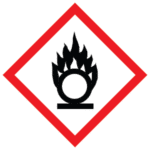
Oxidizing substances
- Substances which, while in themselves are not necessarily combustible, may generally by yielding oxygen cause or contribute to the combustion of other material.
Health Hazard
- Respiratory sensitisation, category 1
- Germ cell mutagenicity, categories 1A, 1B, 2
- Carcinogenicity, categories 1A, 1B, 2
- Reproductive toxicity, categories 1A, 1B, 2
- Specific target organ toxicity following single exposure, categories 1, 2
- Specific target organ toxicity following repeated exposure, categories 1, 2
- Aspiration hazard, categories 1, 2
Irritant
- Acute toxicity (oral, dermal, inhalation), category 4
- Skin irritation, categories 2, 3
- Eye irritation, category 2A
- Skin sensitisation, category 1
- Specific target organ toxicity following single exposure, category 3
- Respiratory tract irritation
- Narcotic effects
Read more about the GHS symbols here
Precautionary statements
Phrases that describe recommended measures that should be taken to minimise or prevent adverse effects resulting from exposure to a hazardous product, or improper storage or handling of a hazardous product. These phrases cover prevention, response, storage, and disposal of products.
Signal word
One word used to indicate the relative severity of hazard and alert the reader to a potential hazard on the label and safety data sheet. These include two signal words:
- “Warning” for less severe hazard categories and;
- “Danger” for more severe hazard categories.

